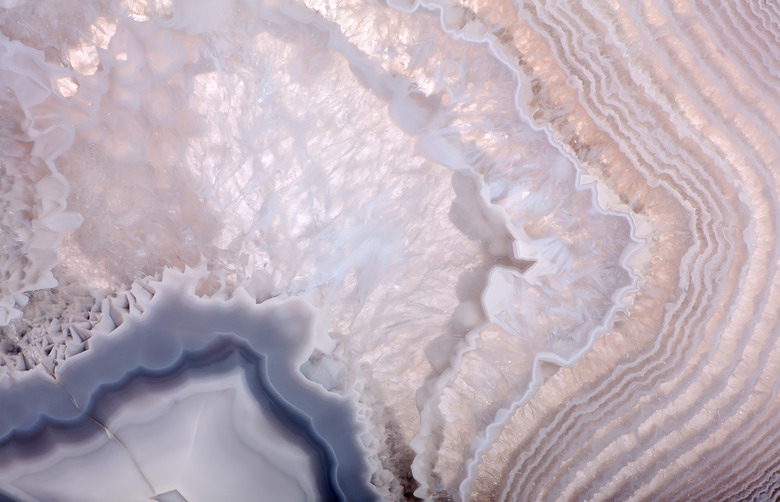Five Characteristics Of A Mineral
You encounter minerals every day, from the quartz inside your watch to the gemstones you wear on your fingers, and yet you may not realize the abundant nature of minerals on Earth. Thousands of minerals have been discovered, but only about 200 are common to the average person. Humans cannot live without minerals as they keep the human body functioning normally. People use minerals every day within their bodies and in many industries, but minerals cannot be made by man.
TL;DR (Too Long; Didn't Read)
Minerals always occur in nature, they are solid and are inorganic. They have a crystal structure and each mineral has a unique chemical composition.
Minerals Are Natural
Minerals Are Natural
You must find minerals in nature; substances concocted in laboratories don't qualify. Although some laboratory products resemble minerals, they are not true minerals. Cubic zirconia and synthetic corundum, substances masquerading as rubies or sapphires in high school graduation rings, are not true minerals because, even though they conform to the other characteristics of minerals, they do not occur in nature. Not all naturally occurring crystals are minerals either; opal and amber, the sap of ancient trees that have fossilized, are not minerals. Substances called mineraloids may look like minerals but are not because they don't satisfy all the requirements for being so.
Minerals Are Inorganic
Minerals Are Inorganic
Minerals don't belong to any class of organic compounds, which include substances such as carbohydrates, proteins and fats made by living things. Almost all known minerals come from inorganic processes — activities that living things cannot carry out. A few minerals, such as pearls and the shells of some creatures, however, do originate from organic processes. All organic substances contain carbon. Inorganic substances also can contain carbon; but the carbon typically bonds with elements other than hydrogen and does not form long chains as it does in carbohydrates and fats.
Minerals Are Solids
Minerals Are Solids
Minerals cannot be liquids or gases; they exist only as solids, a state of matter that possesses a high amount of order. Ions, which are charged atoms, bond together to form minerals, which gives them a solid structure. Solids have a clearly defined volume and shape, and their molecules normally cannot be compressed any further. Their structures are rigid, meaning that the particles within the mineral don't move around. Solids can be crystalline or amorphous. Crystalline solids such as minerals have repeating patterns, whereas amorphous solids such as glass do not.
Definite Chemical Composition
Definite Chemical Composition
Each mineral has its own specific combination of atoms that cannot be found in any other mineral. For example, salt is a mineral that consists of sodium and chlorine ions bonded together in a repeating pattern. Diamonds, on the other hand, have only one type of atom: carbon. The carbon atoms come together extremely tightly in a type of chemical bond different from the one responsible for forming salt, making diamonds the hardest substance on Earth. Some minerals, such as gold, silver, copper and diamond, have only one type of element in them. The largest group of minerals contains some form of silicate, a combination of silicon and oxygen atoms.
Crystalline Structure
Crystalline Structure
Minerals form crystals that contain repeated arrangements of atoms or ions. Each repeating part of a crystal is a unit cell which takes on different shapes depending on the size of the ion or atom and how it attracts other particles. Crystals usually take one of six common shapes. Cubic and tetrahedral forms predominate, although others exist less commonly. Minerals have crystalline structures that form in two ways. Magma or lava — the hot, molten rock that comes from volcanoes — can crystallize to form minerals. Minerals crystallize also form in the oceans when water deposits solutes in a certain area. Crystals appear when the water evaporates.
Cite This Article
MLA
Dinh, Ho-Diep. "Five Characteristics Of A Mineral" sciencing.com, https://www.sciencing.com/five-characteristics-mineral-23695/. 13 April 2018.
APA
Dinh, Ho-Diep. (2018, April 13). Five Characteristics Of A Mineral. sciencing.com. Retrieved from https://www.sciencing.com/five-characteristics-mineral-23695/
Chicago
Dinh, Ho-Diep. Five Characteristics Of A Mineral last modified March 24, 2022. https://www.sciencing.com/five-characteristics-mineral-23695/
